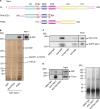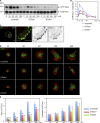Tiam1 interaction with the PAR complex promotes talin-mediated Rac1 activation during polarized cell migration
- PMID: 23071154
- PMCID: PMC3471226
- DOI: 10.1083/jcb.201202041
Tiam1 interaction with the PAR complex promotes talin-mediated Rac1 activation during polarized cell migration
Abstract
Migrating cells acquire front-rear polarity with a leading edge and a trailing tail for directional movement. The Rac exchange factor Tiam1 participates in polarized cell migration with the PAR complex of PAR3, PAR6, and atypical protein kinase C. However, it remains largely unknown how Tiam1 is regulated and contributes to the establishment of polarity in migrating cells. We show here that Tiam1 interacts directly with talin, which binds and activates integrins to mediate their signaling. Tiam1 accumulated at adhesions in a manner dependent on talin and the PAR complex. The interactions of talin with Tiam1 and the PAR complex were required for adhesion-induced Rac1 activation, cell spreading, and migration toward integrin substrates. Furthermore, Tiam1 acted with talin to regulate adhesion turnover. Thus, we propose that Tiam1, with the PAR complex, binds to integrins through talin and, together with the PAR complex, thereby regulates Rac1 activity and adhesion turnover for polarized migration.
Figures







Similar articles
-
The Rac-GAP Bcr is a novel regulator of the Par complex that controls cell polarity.Mol Biol Cell. 2013 Dec;24(24):3857-68. doi: 10.1091/mbc.E13-06-0333. Epub 2013 Oct 23. Mol Biol Cell. 2013. PMID: 24152735 Free PMC article.
-
The Par-Tiam1 complex controls persistent migration by stabilizing microtubule-dependent front-rear polarity.Curr Biol. 2007 Oct 9;17(19):1623-34. doi: 10.1016/j.cub.2007.08.035. Epub 2007 Sep 6. Curr Biol. 2007. PMID: 17825562
-
The adhesion-GPCR BAI1 regulates synaptogenesis by controlling the recruitment of the Par3/Tiam1 polarity complex to synaptic sites.J Neurosci. 2013 Apr 17;33(16):6964-78. doi: 10.1523/JNEUROSCI.3978-12.2013. J Neurosci. 2013. PMID: 23595754 Free PMC article.
-
The guanine nucleotide exchange factor Tiam1: a Janus-faced molecule in cellular signaling.Cell Signal. 2014 Mar;26(3):483-91. doi: 10.1016/j.cellsig.2013.11.034. Epub 2013 Dec 2. Cell Signal. 2014. PMID: 24308970 Review.
-
Tiam1 takes PARt in cell polarity.Trends Cell Biol. 2006 Jun;16(6):308-16. doi: 10.1016/j.tcb.2006.04.001. Epub 2006 May 2. Trends Cell Biol. 2006. PMID: 16650994 Review.
Cited by
-
The on-off relationship of Rho and Rac during integrin-mediated adhesion and cell migration.Small GTPases. 2014;5:e27958. doi: 10.4161/sgtp.27958. Epub 2014 Mar 7. Small GTPases. 2014. PMID: 24607953 Free PMC article. Review.
-
Rho GTPases in collective cell migration.Small GTPases. 2014;5:e28997. doi: 10.4161/sgtp.28997. Epub 2014 May 9. Small GTPases. 2014. PMID: 25054920 Free PMC article. Review.
-
FAK is required for Schwann cell spreading on immature basal lamina to coordinate the radial sorting of peripheral axons with myelination.J Neurosci. 2014 Oct 1;34(40):13422-34. doi: 10.1523/JNEUROSCI.1764-14.2014. J Neurosci. 2014. PMID: 25274820 Free PMC article.
-
Talin1 promotes HCC progression by regulating NRG1/PI3K/AKT pathway.Discov Oncol. 2024 Aug 20;15(1):360. doi: 10.1007/s12672-024-01243-2. Discov Oncol. 2024. PMID: 39162903 Free PMC article.
-
Rac1 recruitment to the archipelago structure of the focal adhesion through the fluid membrane as revealed by single-molecule analysis.Cytoskeleton (Hoboken). 2013 Mar;70(3):161-77. doi: 10.1002/cm.21097. Epub 2013 Mar 5. Cytoskeleton (Hoboken). 2013. PMID: 23341328 Free PMC article.
References
Publication types
MeSH terms
Substances
Grants and funding
LinkOut - more resources
Full Text Sources
Other Literature Sources
Molecular Biology Databases
Research Materials
Miscellaneous

